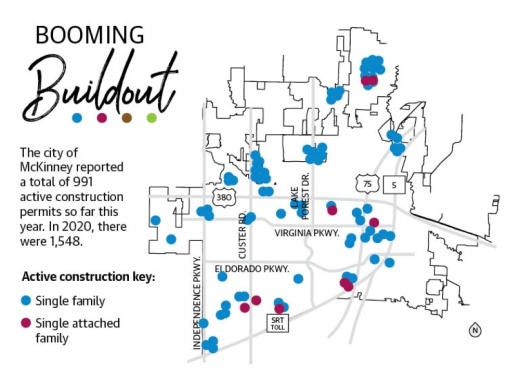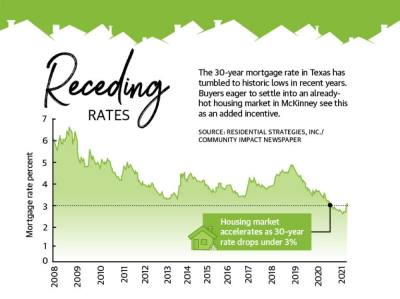Local sources believe factors behind this market dynamic include a prepandemic interest in the Dallas-Fort Worth region that was exacerbated by the global health crisis. The nationwide shortage of building supplies and buyer-friendly financing options have also heavily affected McKinney real estate, sources said.
Realtor Christine Hogan with The Christine Hogan Group in McKinney said the housing shortage is not a new phenomenon—COVID-19 just amplified it.
"Many people do not realize that there has been a shortage of new-build homes since our last recession, and then when COVID-19 hit, it became not just a problem, but a crisis,” Hogan said. “New homebuilders will not catch up for several years.”
Heightened interest
Homebuyers looking to move to McKinney are drawn by quality schools, the historic downtown district and parks and trails, said Debra Brown, principal and Realtor with the Deb Brown Group in McKinney.
“Although McKinney’s population has increased rapidly, it is still a city with charm,” she said. “Relocated buyers tell me regularly how they felt this was the place for them once they drove around McKinney.”
Brown said first-time homebuyers with little money for a down payment have a difficult time competing with cash buyers and those able to make a large down payment.
Numbers from the Collin County Association of Realtors reflect the heightened interest not just in McKinney but in the county overall. CCAR reported county homes in May remained on the market for 67.9% less time than last year and sold for 105.7% of their original list price on average. The median sales price of $437,650 in May is 26.9% more than the year prior.
“Buyers’ agents are sometimes writing numerous offers before getting one accepted,” Brown said.
Sellers are seeing high profit from their sold homes, but Brown added that some profit is lost if they seek a new home.
For Collin County, CCAR reported 0.9 months supply of homes for sale in May. A market is considered balanced when there is a six-month supply of homes for sale. Hogan called the housing market a seller’s market due to imbalanced supply and demand, and believes the housing shortage will continue indefinitely.
Robert Ditthardt, vice president of the Trinity Falls housing development by Johnson Development Corp. in northern McKinney, said there is not enough space to build for all prospective buyers. Ditthardt predicted sales would go up by at least 10% if the company could obtain more lots.
“We have not been able to meet demand,” Ditthardt said. “In conversations with our builders, I’ve heard on a number of occasions that this is something they’ve never seen in their 30 or 40 years in the business.”
More buyers these days seek out new houses within master-planned communities, Ditthardt said. In Trinity Falls, the neighborhood’s open space that is complemented by scenic hike-and-bike trails are main draws.
“Builders have and still do have a large appetite to develop lots,” Ditthardt said. “The demographics here in DFW just continue to support strong housing demand.”
Added incentives
Ditthardt said he believes high demand will continue to be driven by a historically low 30-year mortgage rate in Texas.
Predating the pandemic, the plummeted mortgage rate has been the most significant factor to heightened demand, according to Dallas-based research firm Residential Strategies Inc. The rate in Texas is 2.98%, the first-quarter report from RSI reads, down from just under 5% in 2019.
Ditthardt said the mortgage rate is an added appeal and allows for more first-time homebuyers to acquire loans.
“As long as interest rates remain historically low, most people are expecting this to continue for another couple of years,” he said.
In addition to the low mortgage rate, Jim Gaines, an economist at the Texas Real Estate Research Center, said persistent migration to North Texas will help protect from home value deflation in the local market.
Gaines anticipates a leveling off in prices, but said when it will happen is unclear.
“No one expects the rate of increases that we’ve seen the past year to sustain for much longer,” Gaines said.
Moreover, because of more conservative and sound lending principles by lenders than compared to the Great Recession, Gaines said there is less chance of a wave of foreclosures.
“We don’t think that’s what’s happening today,” Gaines said.
A misaligned market
Phil Crone, director of the Dallas Builders Association, seeks to advocate, educate and communicate on behalf of the builders, remodelers and Realtors who comprise his organization.
Crone said the market is defined by lost business for both homebuilders and buyers.
Supply chain shortages in lumber, semiconductor chips and metals have led to massive price hikes and delays in building, according to the National Association of Home Builders. Crone added that many families are left on the sidelines as average home prices have gone through the roof.
“Builders want to build every home that’s being demanded out there, and the more these prices go up, the fewer people have that opportunity,” Crone said.
Residents value upgraded dwellings more because of the pandemic, Hogan said, leading to a flood of new North Texans.
“Home became more essential than ever,” Crone said. “Everybody realized that, like it or not, they’re going to be spending a lot more time there.”
Steven Ryzewski contributed to this report.







